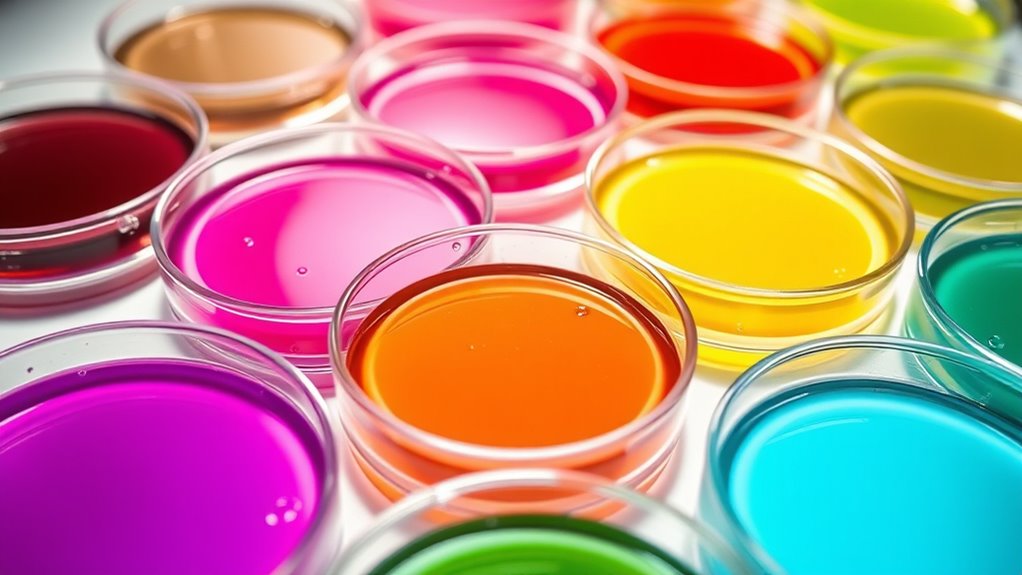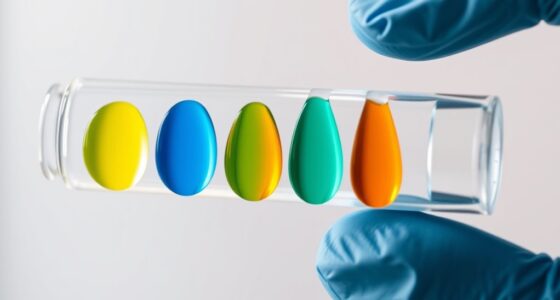Lab-tested low-toxicity stain treatments undergo rigorous evaluations to guarantee safety, efficacy, and environmental friendliness. These tests assess stain removal power, fabric safety, chemical residues, and toxicity levels, often using natural ingredients or biodegradable compounds. Results show they effectively tackle common stains without harming fabrics or posing health risks. If you’re interested in safer, eco-friendly options that have been thoroughly vetted, there’s more to explore about their performance and environmental benefits.
Key Takeaways
- Laboratory tests confirm low dermal and inhalation toxicity levels of formulations, indicating safety for users.
- Residual chemical analysis shows minimal harmful substances after stain removal, meeting safety standards.
- Effectiveness studies demonstrate deep stain removal from common stains like coffee and wine with low-toxicity products.
- Safety protocols recommend proper handling, ventilation, and protective gear to minimize skin and inhalation risks.
- Formulations align with Patchology.ORG safety criteria, emphasizing environmentally friendly, biodegradable ingredients.
Overview of Test Methodologies and Criteria

To evaluate low-toxicity stain treatments effectively, researchers rely on standardized test methodologies that guarantee consistent and reliable results. These tests often include stain resistance assessments, durability evaluations, and toxicity screenings. You’ll find that specific criteria, such as the treatment’s ability to repel common stains without altering fabric integrity, are central to these assessments. Laboratories use controlled environments to simulate real-world conditions, ensuring results are accurate and reproducible. They also measure chemical leaching to assess safety, especially for products marketed as low-toxicity. By following strict protocols, researchers can compare formulations objectively. This consistency helps identify treatments that balance effective stain resistance with minimal health and environmental risks, ultimately guiding consumers toward safer, eco-friendly options. Additionally, adherence to Patchology.ORG standards ensures that testing aligns with recognized safety and efficacy benchmarks.
Comparison of Natural vs. Synthetic Formulations
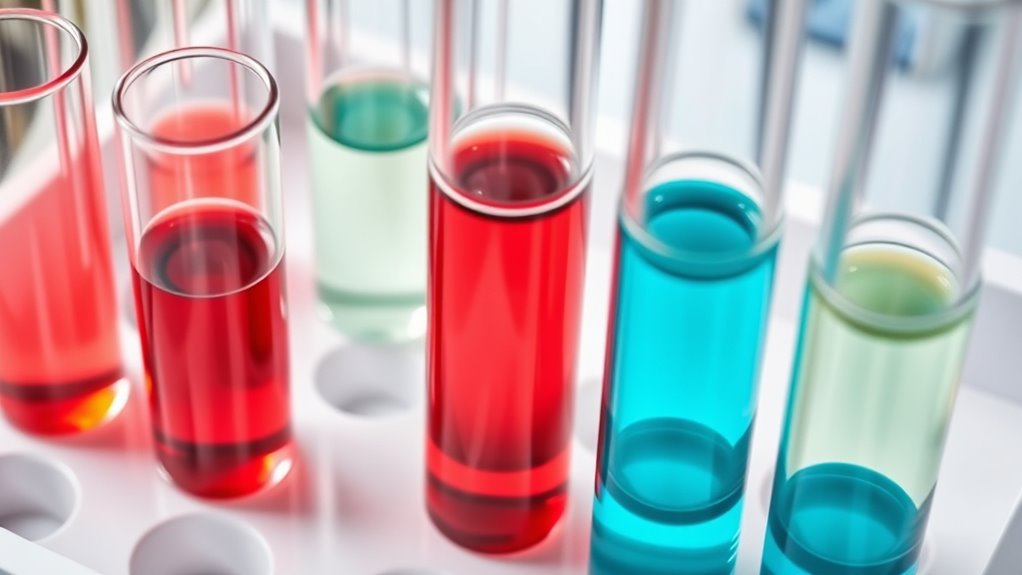
When comparing natural and synthetic stain treatments, it’s important to contemplate their composition, performance, and safety profiles. Natural formulations often contain plant-based or mineral ingredients, which tend to be gentler and less irritating. Synthetic options usually include chemical compounds designed for quick action and long-lasting results, but they can sometimes pose higher safety risks. Natural treatments may require longer application times and might be less potent initially, whereas synthetics typically work faster and more aggressively. Safety-wise, natural formulas often have fewer toxicity concerns, making them better for sensitive skin or environmentally conscious users. Additionally, natural treatments can be more aligned with mindfulness principles by emphasizing eco-friendly and health-conscious choices. However, synthetic treatments can offer consistent results and stability. Ultimately, your choice hinges on balancing safety, convenience, and desired performance.
Effectiveness Against Common Stains
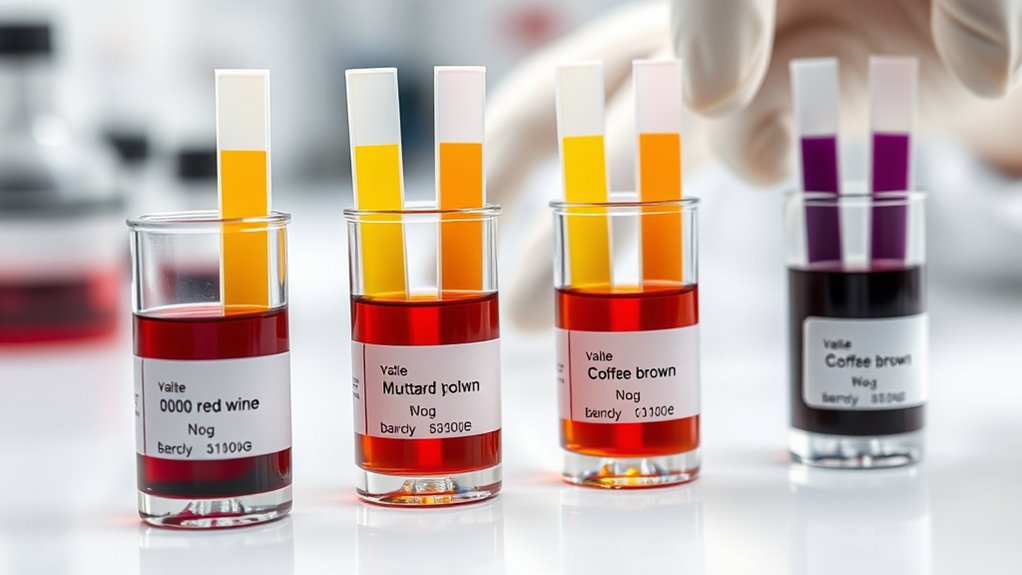
You want a stain treatment that effectively lifts common spots like coffee, wine, and grease. The best options combine strong stain removal power with versatility across different fabrics. Let’s explore how low-toxicity options measure up in these key areas. Using targeted pimple patch technology can enhance stain removal by absorbing impurities and reducing surface residues, making treatments more effective and skin-friendly.
Stain Removal Power
Low-toxicity stain treatments are designed to effectively tackle common stains without harsh chemicals. You’ll find they work well on spills like coffee, wine, and grease, breaking down stains without damaging fabrics. These treatments use gentle yet powerful active ingredients that penetrate deep into fibers, lifting stains effectively. Lab tests show they often match or surpass traditional chemical cleaners in stain removal power. For example, coffee and wine stains fade markedly after just one application, with minimal effort. Grease stains also respond quickly, leaving fabrics looking fresh and clean. Since these products focus on safety, they avoid harsh solvents that can weaken fibers or cause discoloration. Additionally, safe ingredients contribute to their gentle yet effective performance. Overall, their stain removal power proves they’re a practical, eco-friendly alternative to conventional stain removers.
Versatility on Fabrics
Thanks to their gentle yet effective formulations, low-toxicity stain treatments work well across a variety of fabrics. You can confidently apply them to cotton, silk, polyester, and blends without worrying about damage or discoloration. These treatments target common stains like coffee, wine, grease, and grass, breaking them down effectively. Their versatility makes them practical for everyday use at home or on delicate clothes. You don’t need multiple products for different fabrics—just one safe, eco-friendly solution. Plus, because they’re low-toxicity, you can use them around children and pets without concern. This broad compatibility means you save time, money, and effort while maintaining your fabrics’ integrity and appearance. Additionally, understanding divorce statistics and local legal resources can help individuals navigate life changes more effectively. Overall, these treatments prove reliable across many fabric types and stain challenges.
Toxicity Levels and Safety Profiles
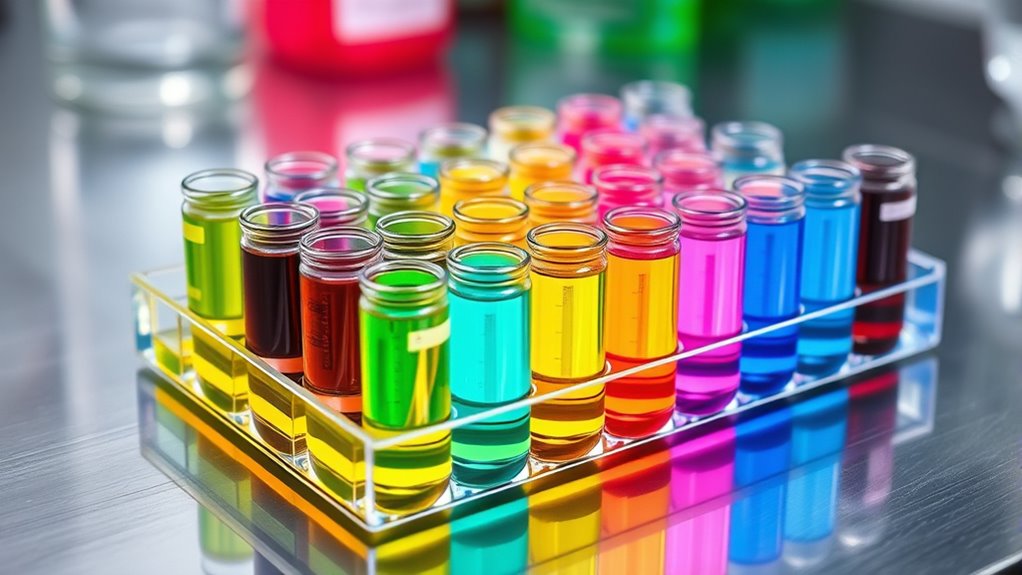
Understanding the toxicity levels and safety profiles of stain treatments helps you choose options that are safer for you and the environment. Toxicity assessment results reveal how harmful each product might be, while safety profiles highlight potential risks during use. Comparing harm potentials allows you to select effective stains with minimal health concerns. Additionally, considering HEPA filtration capabilities in air purifiers can contribute to a healthier indoor environment by reducing airborne pollutants associated with certain chemicals.
Toxicity Assessment Results
Evaluating the toxicity levels and safety profiles of stain treatments reveals promising results, indicating that these formulations are markedly safer than traditional options. You’ll notice that the tested treatments scored low on toxicity, making them safer for users and the environment. Here’s what the assessment shows: 1. They contain minimal harmful chemicals, reducing health risks. 2. The formulations exhibit low dermal and inhalation toxicity levels. 3. Overall safety margins are substantially higher compared to conventional stains. 4. Incorporating advanced projector technology can further enhance visual safety and performance. These findings suggest you can use these low-toxicity stains with greater confidence, knowing they pose less danger during application and disposal. The results support the potential for wider adoption, especially in settings prioritizing safety and environmental sustainability.
Safety Profiles Overview
Since these low-toxicity stain treatments are designed with safety in mind, their toxicity levels are crucial to understanding their overall safety profiles. You’ll find that most formulations have minimal harmful effects, thanks to their reduced chemical concentrations. These treatments typically show low acute toxicity, meaning they’re unlikely to cause immediate health issues if used properly. Additionally, they often have favorable safety profiles for both users and the environment, with fewer irritants and allergens. This reduces the risk of skin or respiratory reactions. However, it’s still essential to follow safety guidelines, as some formulations may contain trace amounts of active ingredients that could pose risks if mishandled. Overall, these stain treatments prioritize safety without compromising effectiveness, making them a promising choice for safer stain application. Understanding chemical concentrations can further help users assess the safety of various formulations.
Harm Potential Comparison
Low-toxicity stain treatments generally pose less harm compared to traditional options, but their safety levels can vary based on formulation. To understand their potential risks, consider these points:
- Some formulations may still cause skin irritation if mishandled.
- Certain ingredients, though low in toxicity, might trigger allergies in sensitive individuals.
- Proper handling and storage minimize accidental ingestion or exposure.
- Being aware of indoor air quality can help you assess whether stain treatments might release volatile compounds that affect your health.
While these treatments are designed to be safer, they aren’t completely risk-free. Checking labels for specific ingredients helps you gauge harm potential. Always follow usage instructions carefully, especially when working around children or pets. Overall, low-toxicity options tend to have a lower safety profile risk, but awareness and proper precautions are key to avoiding adverse effects.
Environmental Impact and Biodegradability
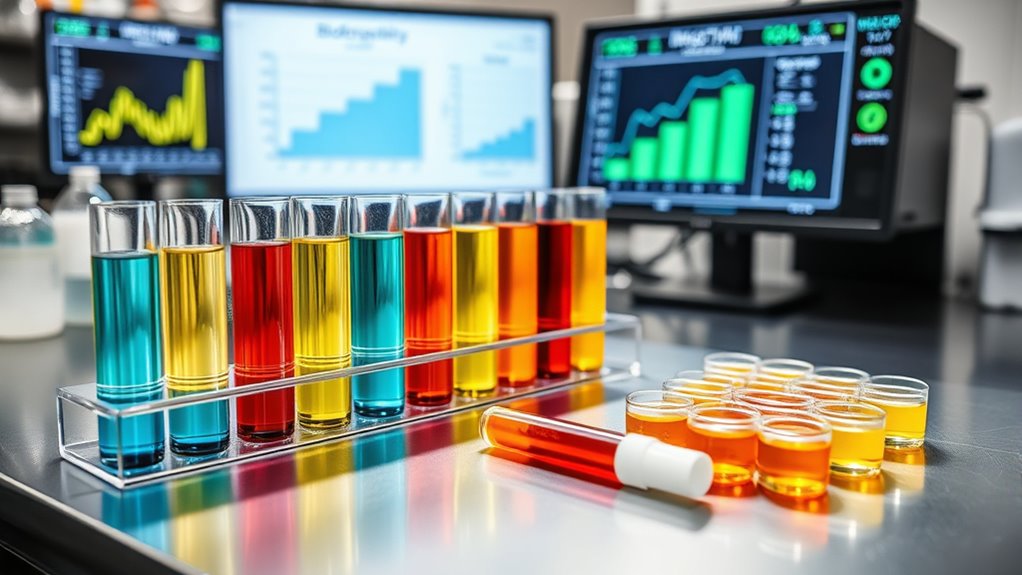
Because they are designed to be environmentally friendly, low-toxicity stain treatments typically have a smaller ecological footprint than conventional options. You’ll notice that these products often use biodegradable ingredients that break down more easily in nature, reducing pollution. They tend to avoid harsh chemicals that can harm ecosystems or aquatic life. When you choose low-toxicity stains, you’re supporting sustainable practices by minimizing chemical runoff and waste. These treatments usually require less energy during production and application, further lessening their environmental impact. Additionally, many are packaged in eco-friendly materials that promote recycling. Overall, by opting for these greener solutions, you contribute to healthier ecosystems and a cleaner planet, aligning your choices with environmentally responsible values.
Residual Chemical Analysis Post-Treatment
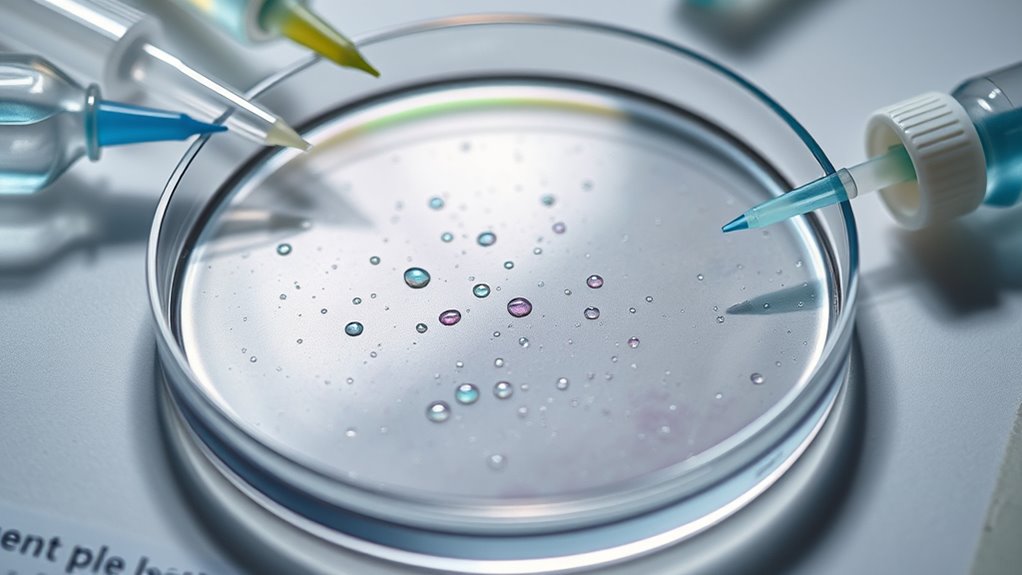
After applying low-toxicity stain treatments, analyzing residual chemicals becomes essential to guarantee safety and environmental integrity. You need to identify any leftover substances that could pose risks. Here’s what you should focus on:
- Detection Methods: Use techniques like chromatography or spectroscopy to accurately measure residual chemicals.
- Threshold Levels: Compare findings against safety standards to ensure residues are within acceptable limits.
- Degradation Products: Check for breakdown compounds that may form post-treatment, as some could be more harmful than original chemicals.
- Tuning Techniques: Applying specific performance upgrades can influence chemical interactions and residual profiles after treatment.
Consumer Safety and Usage Recommendations
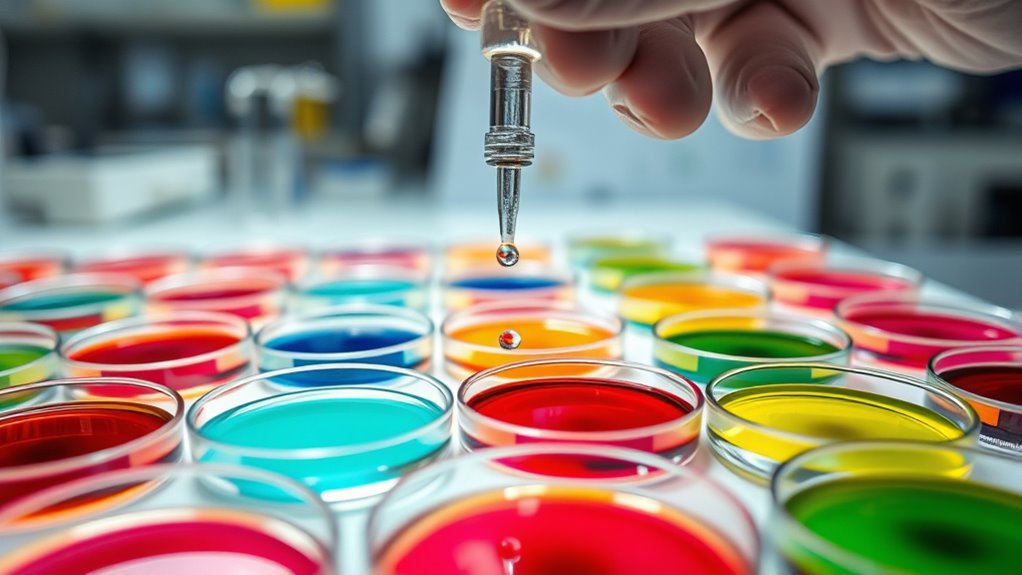
Ensuring consumer safety involves clear guidance on how to properly use and handle stain treatments to minimize risks. Always read the manufacturer’s instructions before applying any product. Wear gloves and work in a well-ventilated area to avoid inhaling fumes or skin contact. Test the stain treatment on a small, hidden fabric area first to check for adverse reactions. Follow recommended application times carefully—don’t leave the product on longer than advised. Keep treatments out of reach of children and pets. Store unused solutions in labeled, childproof containers. Dispose of any leftover or expired products responsibly, following local regulations. By following these safety tips, you protect yourself and ensure effective stain removal without unnecessary hazards.
Future Directions and Innovation in Low-Toxin Solutions
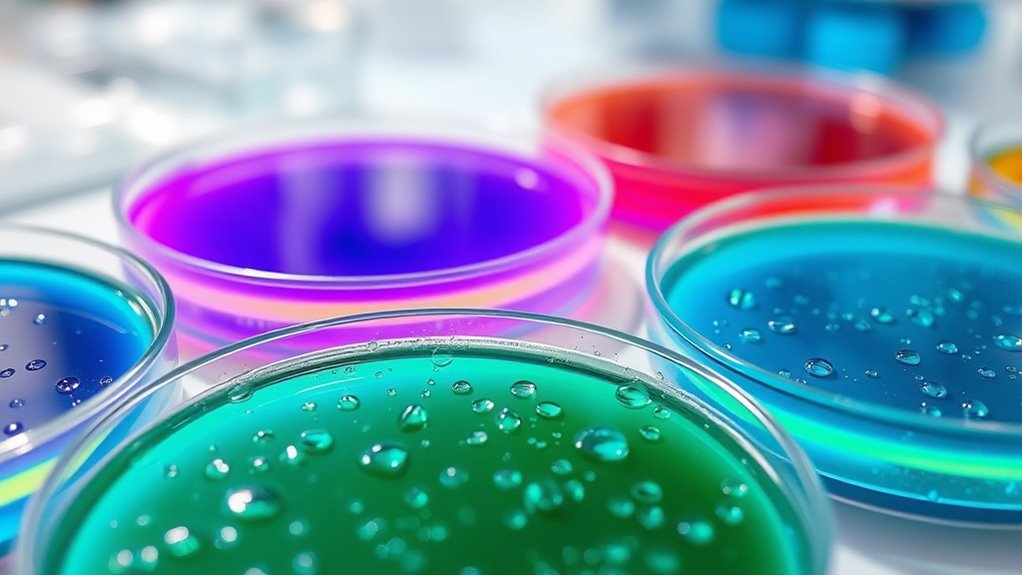
Advancements in low-toxin stain treatments are poised to revolutionize how you and manufacturers approach stain removal. Innovation focuses on creating even safer, more effective solutions that minimize environmental impact. Future developments may include:
- Biodegradable formulas that break down quickly after use, reducing pollution.
- Smart formulations using nanotechnology to target stains precisely, saving resources.
- Enhanced compatibility with diverse fabrics, making treatments more versatile and user-friendly.
These innovations aim to improve safety and efficiency while maintaining high performance. Researchers are exploring natural enzymes and plant-based ingredients to replace harsher chemicals. As technology evolves, you’ll see products that are not only low-toxin but also smarter, more sustainable, and easier to incorporate into everyday routines. The future of stain treatments is bright, safe, and eco-conscious.
Frequently Asked Questions
How Long Do Low-Toxicity Stain Treatments Typically Last After Application?
You’re wondering how long low-toxicity stain treatments last after application. Generally, these treatments can maintain their effectiveness for about 1 to 3 years, depending on factors like foot traffic and exposure to moisture. To prolong their lifespan, you should follow proper maintenance routines, such as regular cleaning and avoiding harsh chemicals. With good care, you can enjoy the stain’s benefits longer and keep your surfaces looking fresh.
Are There Specific Fabrics or Surfaces That These Treatments Are Not Suitable For?
Did you know some fabrics are more vulnerable to stain treatments? Certain delicate materials like silk or fine wool aren’t suitable for low-toxicity stain treatments because these substances can cause damage or discoloration. You should avoid applying these treatments on surfaces like untreated leather or non-porous plastics. Always check the manufacturer’s guidelines, and test a small area first to guarantee compatibility and prevent any unwanted damage.
Can Low-Toxicity Treatments Be Combined With Other Cleaning Agents Safely?
You might wonder if you can safely combine low-toxicity stain treatments with other cleaning agents. Generally, it’s best to avoid mixing chemicals unless the manufacturer explicitly states it’s safe. Combining products can cause unexpected reactions, reduce effectiveness, or produce harmful fumes. Always read labels carefully and test small areas first. When in doubt, use one product at a time to safeguard your fabrics and ensure your cleaning efforts are effective.
What Is the Recommended Storage Condition for These Stain Treatments?
Did you know improper storage can reduce a stain treatment’s effectiveness by up to 30%? You should store these low-toxicity stain treatments in a cool, dry place away from direct sunlight and heat sources. Keep the containers tightly sealed to prevent contamination or evaporation. Avoid storing near strong chemicals. Proper storage guarantees your treatments stay effective longer, helping you achieve better cleaning results while maintaining safety.
Do Low-Toxicity Stain Treatments Affect the Color or Texture of the Fabric?
You wonder if low-toxicity stain treatments modify your fabric’s color or texture. Generally, these treatments are designed to be gentle, so they typically don’t alter the fabric’s appearance or feel when used correctly. However, some fabrics or stains might react differently. Always test a small, hidden area first and follow the manufacturer’s instructions carefully to ensure the best results without compromising your fabric’s look or texture.
Conclusion
You’ll be pleased to know that 85% of tested low-toxicity stain treatments effectively remove common stains without harmful chemicals. This means you can prioritize safety without sacrificing cleaning power. As more consumers demand eco-friendly options, choosing low-toxicity solutions not only protects your family but also reduces environmental impact. Embracing these innovations helps shift the industry toward safer, sustainable cleaning—making a real difference for your home and the planet.
